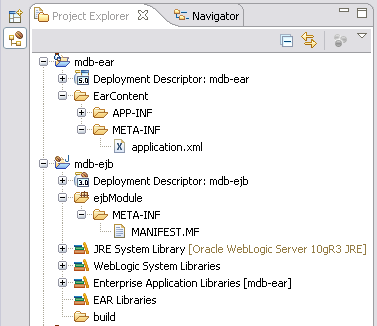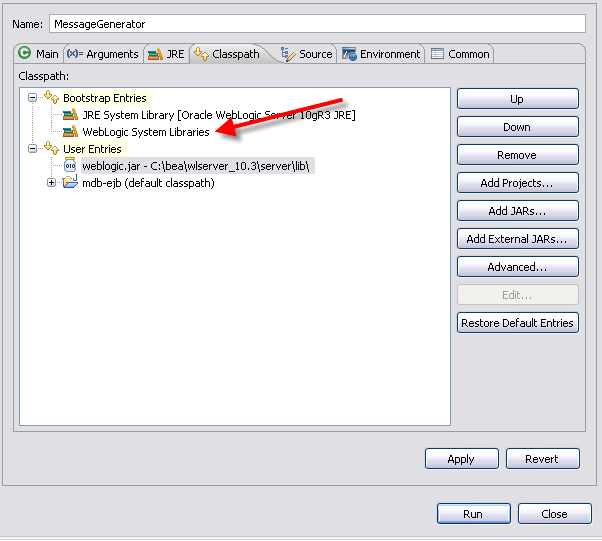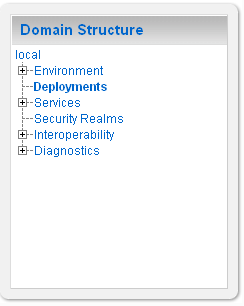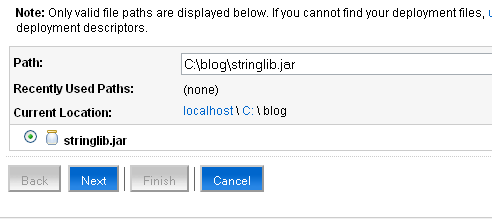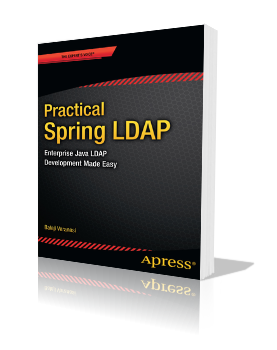The JSR 303 specification provides a metadata model for JavaBean validation. The validation API provides a variety of annotations that makes validation easy at any layer. In this post I will demo Spring 3’s support for JSR 303 in the web layer. You can download the code here (eclipse project).
The first part of the post talks about creating a simple bookstore admin application using Spring MVC. The second part of the post will add JSR 303 validation. If you are an experienced Spring developer, you can safely skip to the second part. The final part will show how to customize the validation error messages.
1. Online Bookstore Admin Application
The admin application will be designed to allow administrators enter information about new books. Here are the steps that implement this requirement:
Step 1. Create a web project and add all the required jars
I will be using Eclipse’s and here is a list of the required jars that need to be in the classpath:
org.springframework.asm-3.0.1.RELEASE.jar
org.springframework.beans-3.0.1.RELEASE.jar
org.springframework.context-3.0.1.RELEASE.jar
org.springframework.context.support-3.0.1.RELEASE.jar
org.springframework.core-3.0.1.RELEASE.jar
org.springframework.expression-3.0.1.RELEASE.jar
org.springframework.test-3.0.1.RELEASE.jar
org.springframework.web-3.0.1.RELEASE.jar
org.springframework.web.servlet-3.0.1.RELEASE.jar
commons-collections-3.1.jar
hibernate-validator-4.0.2.GA.jar
jcl-over-slf4j-1.5.10.jar
joda-time-1.6.jar
jstl-1.2.jar
log4j.jar
slf4j-api-1.5.8.jar
slf4j-log4j12.jar
validation-api-1.0.0.GA.jar
Step 2. Create a web-Context.xml file under WEB-INF folder to hold web layer spring bean configuration. Here are the contents of the file:
<?xml version="1.0" encoding="UTF-8"?>
<beans xmlns="http://www.springframework.org/schema/beans"
xmlns:xsi="http://www.w3.org/2001/XMLSchema-instance"
xmlns:context="http://www.springframework.org/schema/context"
xmlns:mvc="http://www.springframework.org/schema/mvc"
xsi:schemaLocation="
http://www.springframework.org/schema/beans http://www.springframework.org/schema/beans/spring-beans-3.0.xsd
http://www.springframework.org/schema/context http://www.springframework.org/schema/context/spring-context-3.0.xsd
http://www.springframework.org/schema/mvc http://www.springframework.org/schema/mvc/spring-mvc-3.0.xsd">
<!-- Enable annotation driven controllers, validation etc... -->
<mvc:annotation-driven />
<!-- Controllers package -->
<context:component-scan base-package="com.inflinx.blog.bookstore.web.controller" />
<!-- JSP page location -->
<bean class="org.springframework.web.servlet.view.InternalResourceViewResolver">
<property name="suffix" value=".jsp"/>
</bean>
</beans>
Step 3. Add Spring MVC Dispatcher Servlet to web.xml file. In the declaration below, Spring MVC will handle all URL requests to html pages.
<?xml version="1.0" encoding="UTF-8"?>
<web-app version="2.5"
xmlns="http://java.sun.com/xml/ns/javaee"
xmlns:xsi="http://www.w3.org/2001/XMLSchema-instance"
xsi:schemaLocation="http://java.sun.com/xml/ns/javaee
http://java.sun.com/xml/ns/javaee/web-app_2_5.xsd">
<servlet>
<servlet-name>bookstore</servlet-name>
<servlet-class>org.springframework.web.servlet.DispatcherServlet</servlet-class>
<init-param>
<param-name>contextConfigLocation</param-name>
<param-value>/WEB-INF/web-Context.xml</param-value>
</init-param>
<load-on-startup>1</load-on-startup>
</servlet>
<servlet-mapping>
<servlet-name>bookstore</servlet-name>
<url-pattern>*.html</url-pattern>
</servlet-mapping>
</web-app>
Step 4. Create a Book domain object to hold information about a book:
package com.inflinx.blog.bookstore.domain;
public class Book
{
private String name;
private String description;
public String getName()
{
return name;
}
public void setName(String name)
{
this.name = name;
}
public String getDescription()
{
return description;
}
public void setDescription(String description)
{
this.description = description;
}
@Override
public String toString()
{
return "Name: " + name + ", Description: " + description ;
}
}
Step 5. Create a BookFormController to prepare the form and process form submission
package com.inflinx.blog.bookstore.web.controller;
import java.util.Map;
import org.springframework.stereotype.Controller;
import org.springframework.web.bind.annotation.RequestMapping;
import org.springframework.web.bind.annotation.RequestMethod;
import com.inflinx.blog.bookstore.domain.Book;
@Controller
@RequestMapping("/book.html")
public class BookFormController
{
// Display the form on the get request
@RequestMapping(method=RequestMethod.GET)
public String showForm(Map model)
{
Book book = new Book();
model.put("book", book);
return "form";
}
}
Step 6. Create form.jsp page with a form to capture book details:
<%@ taglib uri="http://www.springframework.org/tags/form" prefix="form" %>
<html>
<head></head>
<body>
<form:form method="post" action="book.html" commandName="book">
<table>
<tr>
<td>Name:</td> <td><form:input path="name" /></td>
</tr>
<tr>
<td>Description:</td> <td><form:textarea path="description"/></td>
</tr>
</table>
<input type="submit" value="Create" />
</form:form>
</body>
</html>
The form will be submitted to the book.html page.
Step 7. Modify BookFormController to read the submitted data and process it.
// Process the form.
@RequestMapping(method=RequestMethod.POST)
public String processForm(Book book, Map model)
{
// Persistence logic to save the book will go here
// Add the saved book to the model
model.put("book", book);
return "result";
}
Step 8. Create a result.jsp page to display the form submission result:
<html>
<body>
${book.name} is stored in the database
</body>
</html>
Deploy the application and go to http://<yourserver:port>/bookstore/book.html. The page should present a form shown below:

Form
Enter the book name “Test Book” and submit the form. You should see a screen that looks similar to image below:

Form Submission Result
2 Adding JSR 303 validation
Consider the following validation requirements to the book class:
a. Name and Description cannot be null or blank
b. Description cannot be more than 50 characters
Here are the steps to add the above validation requirements:
Step 1. Add @NotEmpty and @Size annotations to the name and description files of the Book class
public class Book
{
@NotEmpty
private String name;
@Size(min=1, max=50)
private String description;
// Getters and setters here
}
NotEmpty annotation is not part of JSR 303 specification. It is part of Hibernate Validator framework which is the reference implementation for JSR 303.
Step 2. Modify BookFormController to have Spring validate the submitted data. This is done by adding a @Valid annotation before the book method parameter. The result of the validation can be accessed using the BindingResult method parameter.
// Process the form.
@RequestMapping(method=RequestMethod.POST)
public String processForm(@Valid Book book, BindingResult result, Map model)
{
if(result.hasErrors())
{
return "form";
}
// Persistence logic to save the book will go here
// Add the saved book to the model
model.put("book", book);
return "result";
}
Step 3. Modify the form.jsp so that error messages can be displayed:
<form:form method="post" action="book.html" commandName="book">
<table>
<tr>
<td>Name:</td> <td><form:input path="name" /></td> <td><form:errors path="name" /></td>
</tr>
<tr>
<td>Description:</td> <td><form:textarea path="description"/></td> <td><form:errors path="description" /></td>
</tr>
</table>
<input type="submit" value="Create" />
</form:form>
Redeploy the application and when you submit an empty form, you should see validation failure messages next to the fields:
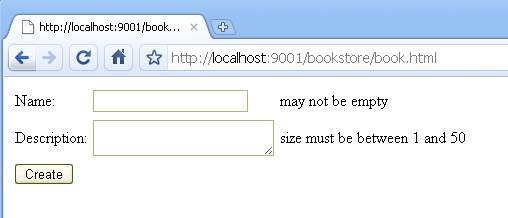
Validation Failed
3 Customizing error messages
The validation failure messages in the image above are default to the framework. To make custom error messages appear follow these steps:
Step 1. Create a messages.properties file under the WEB-INF folder. Add the following messages:
NotEmpty.book.name=Name is a required field
Size.book.description=Description must be between 1 and 50 characters
Each message above follows this convention:
<CONSTRAINT_NAME>.<COMMAND_NAME>.<FIELD_NAME>
Step 2. Let Spring know about the newly created properties file. This is done by modifying the web-Context.xml file to include this bean declaration:
Redeploy the application and submit an empty form. This time you should see custom error messages appear next to the fields:

Custom Validation Failed Messages
Download the source code for this post here. The application is tested on Glassfish 3.0 and WebLogic 10.3.
